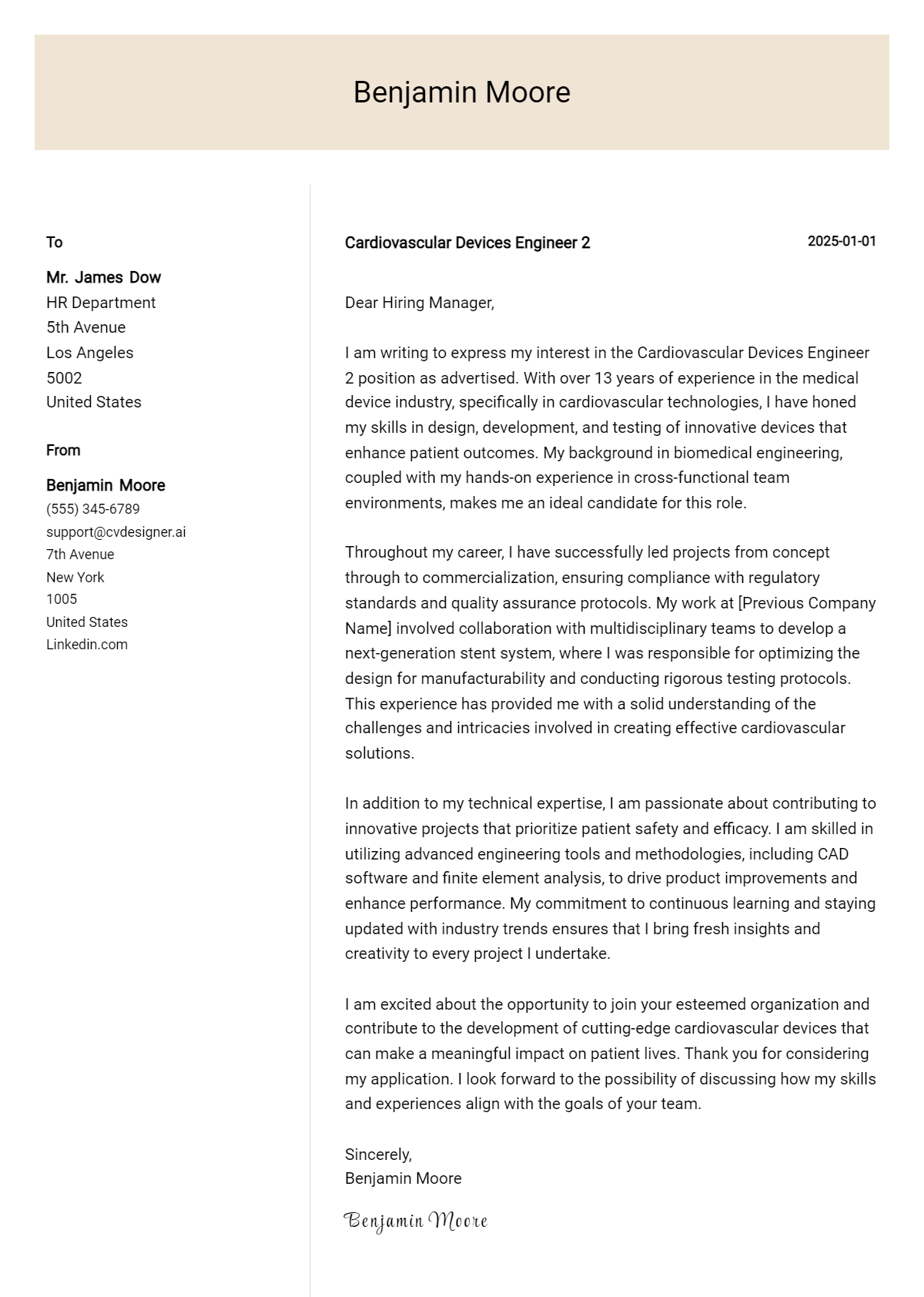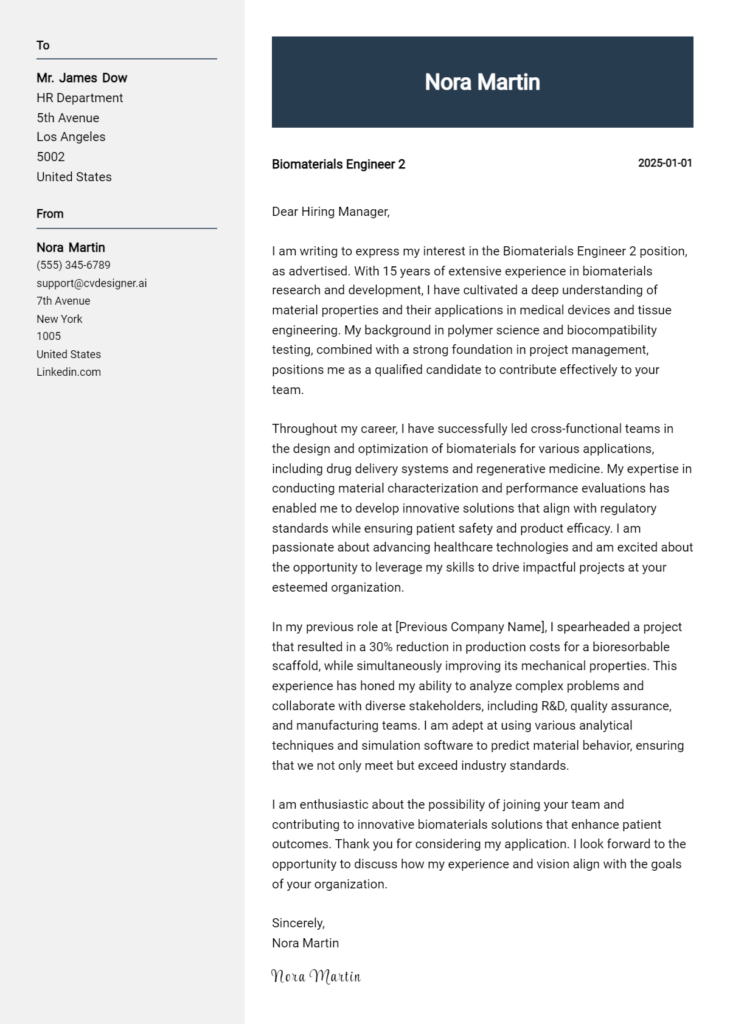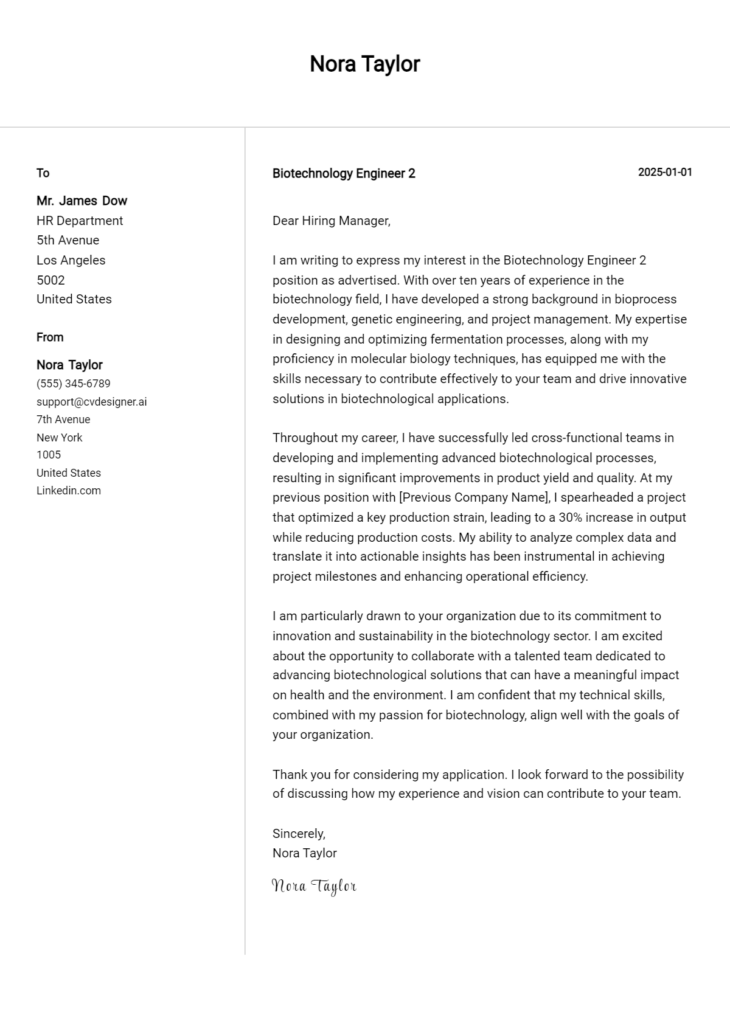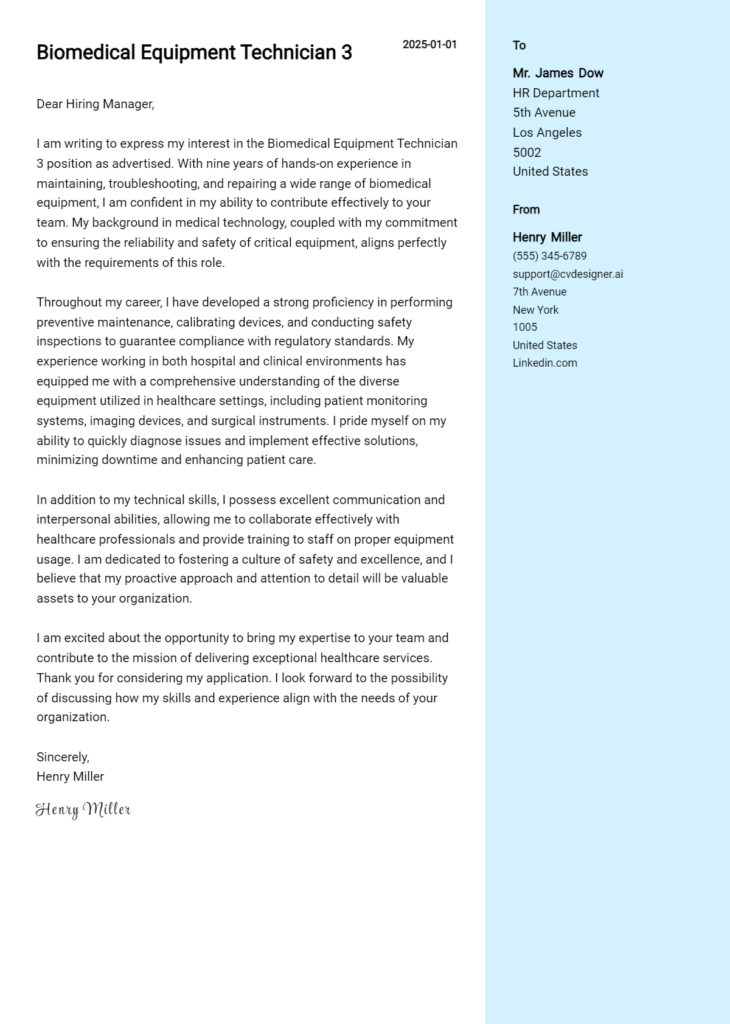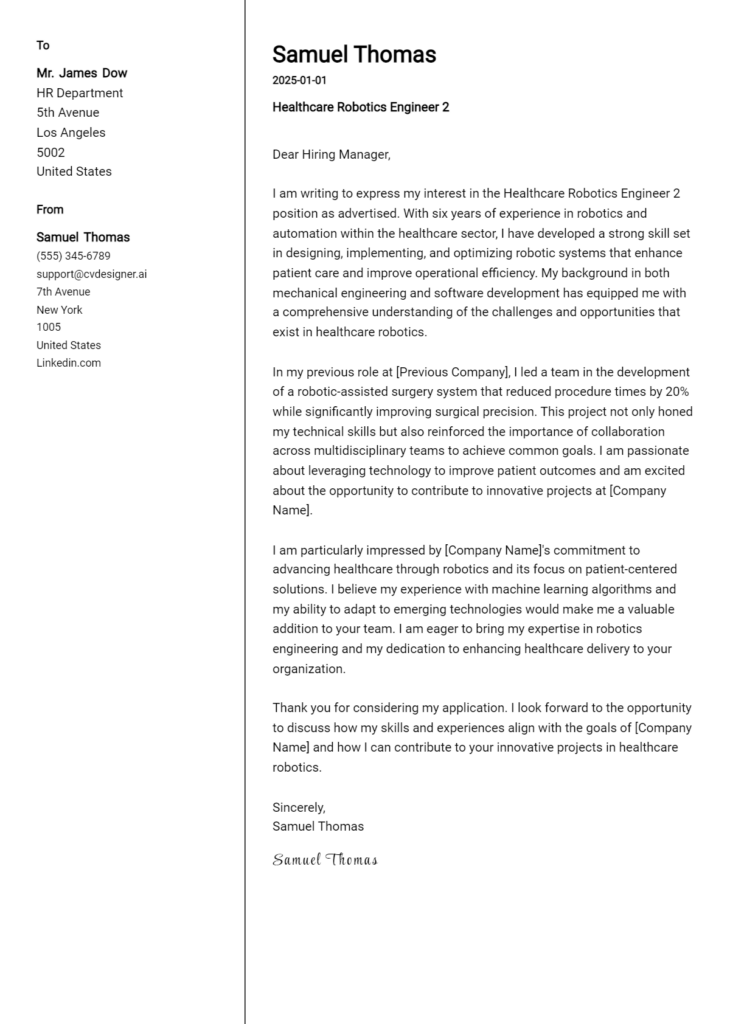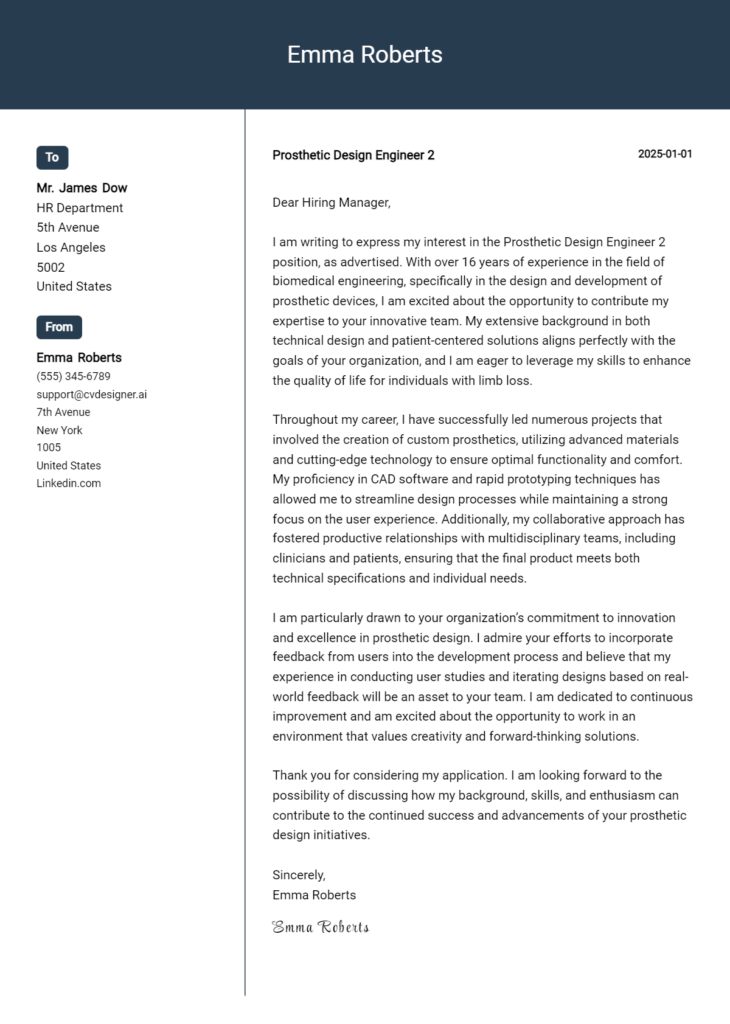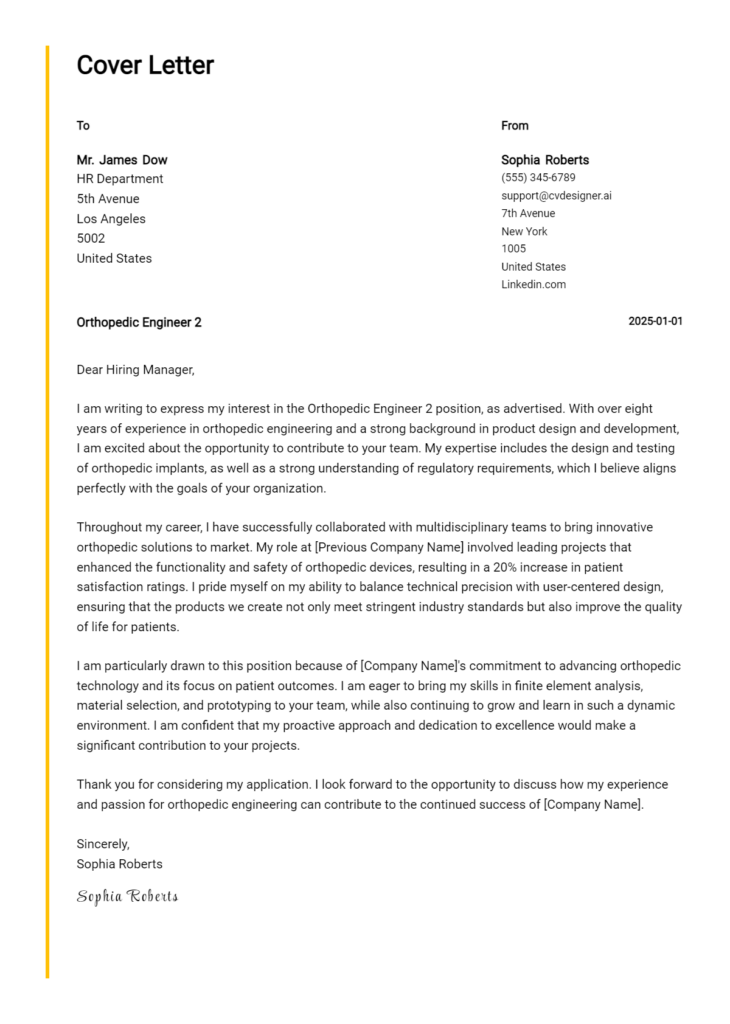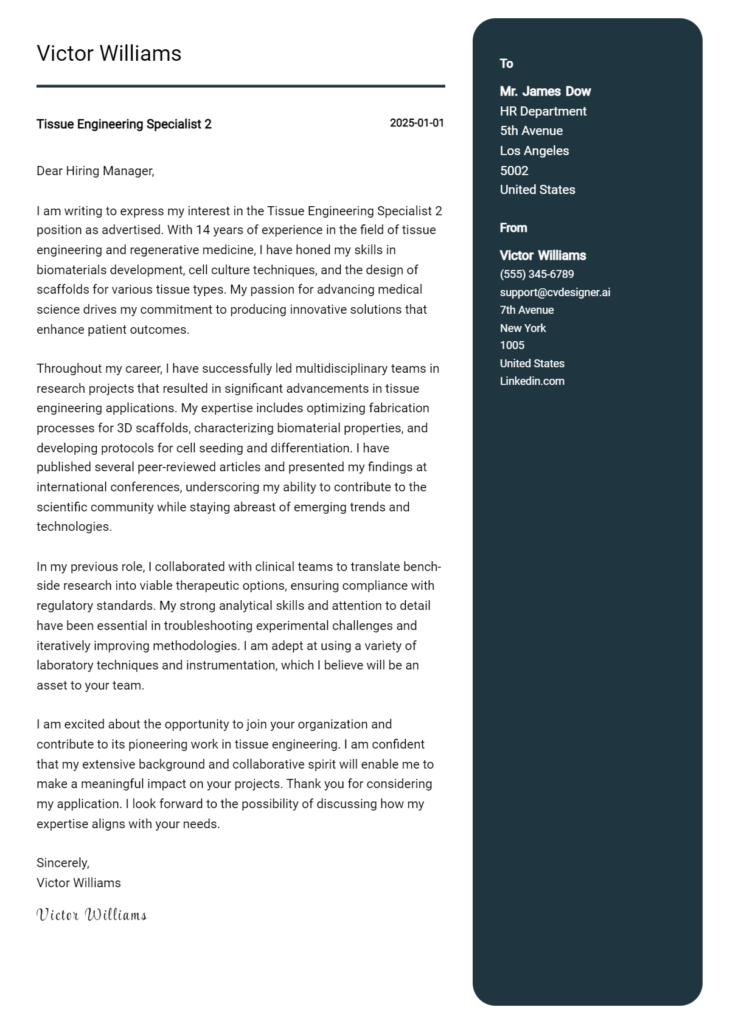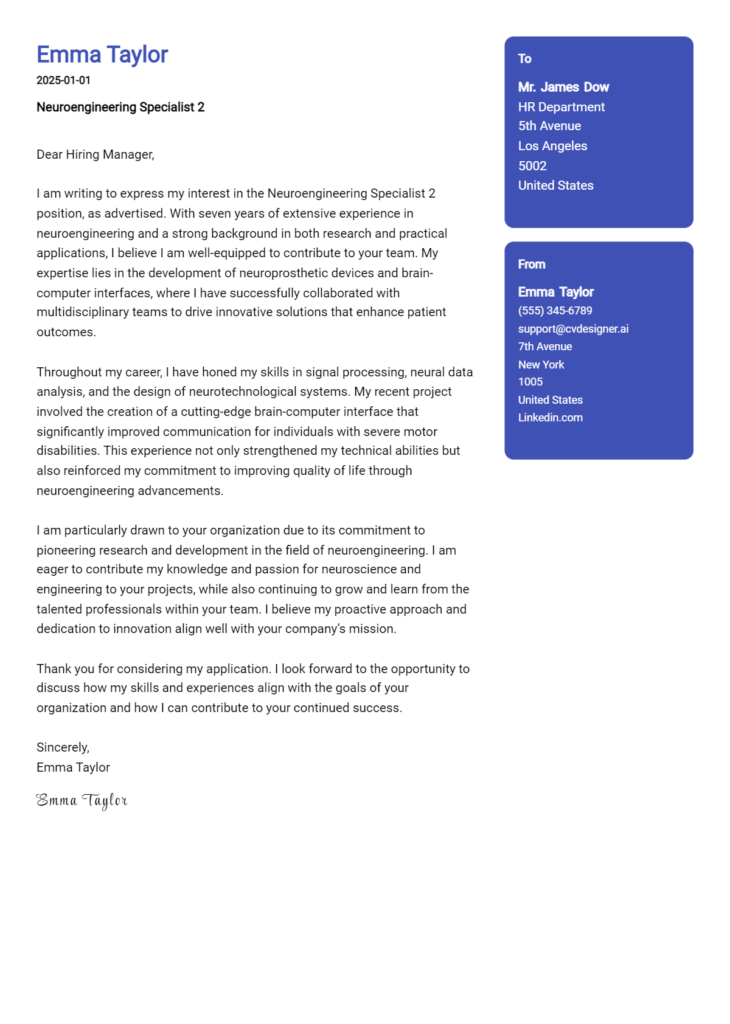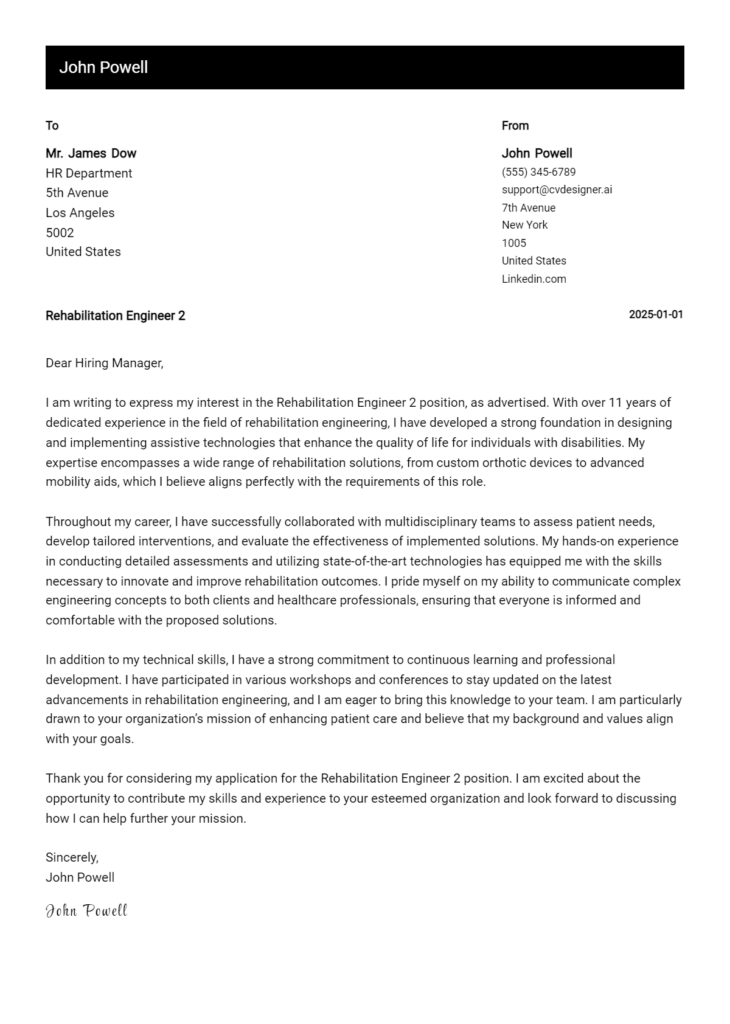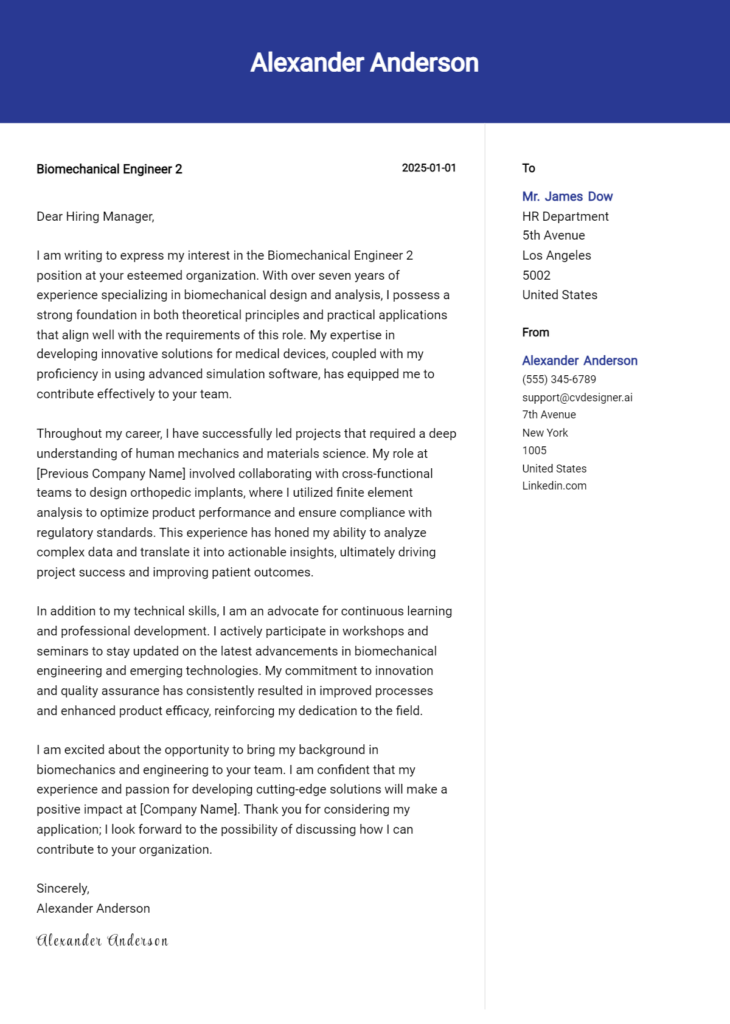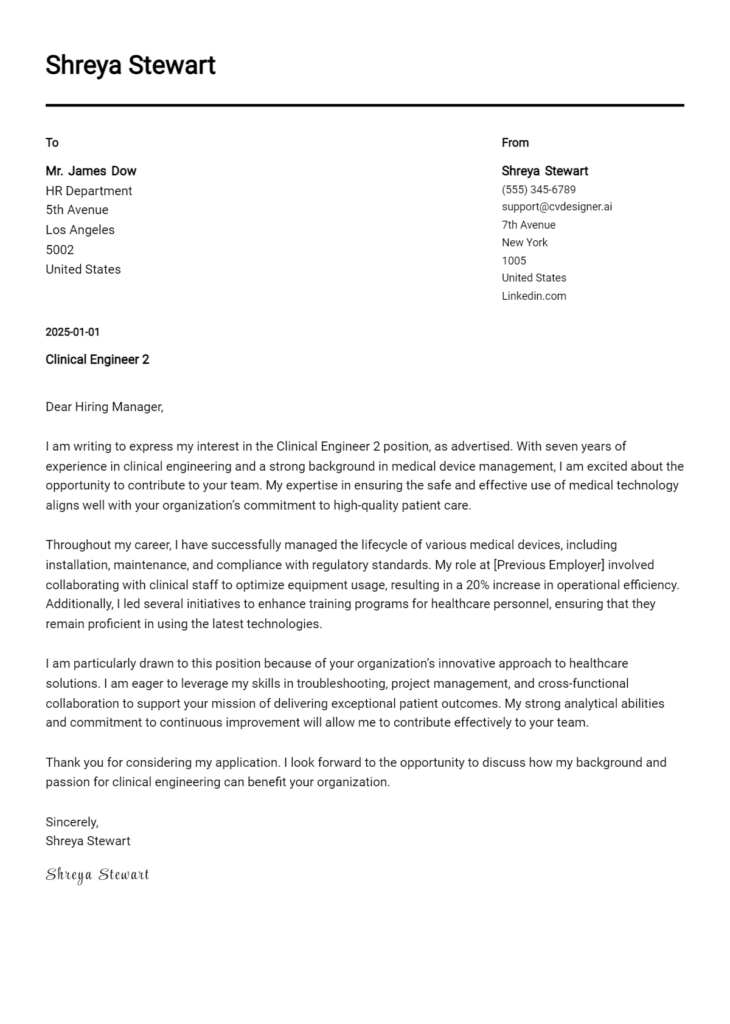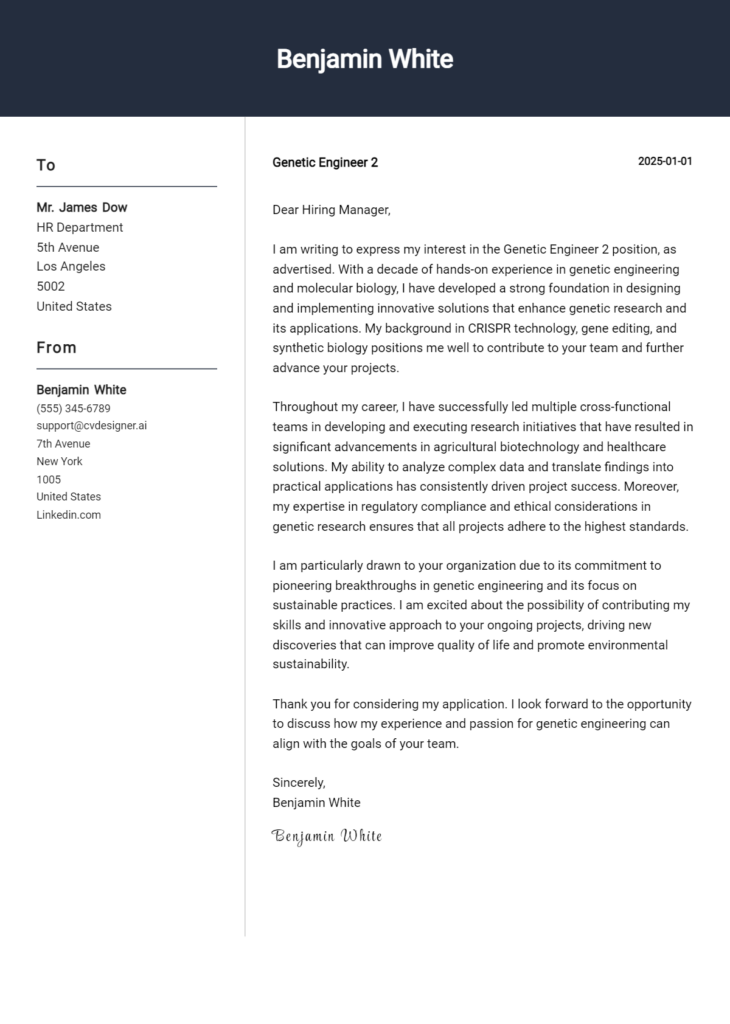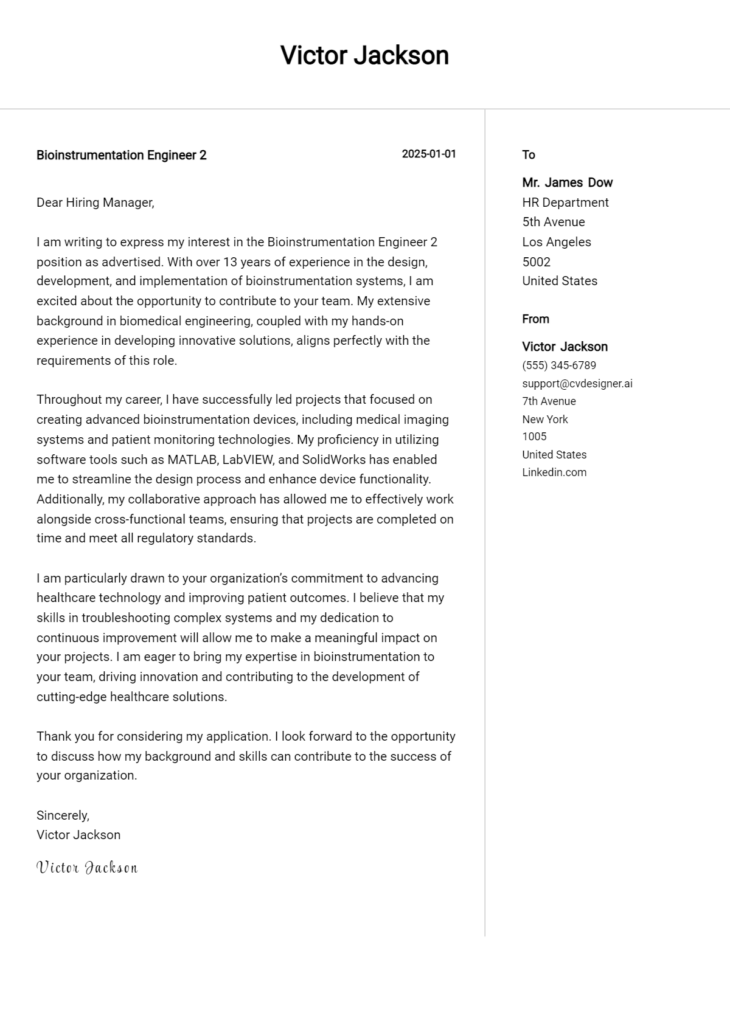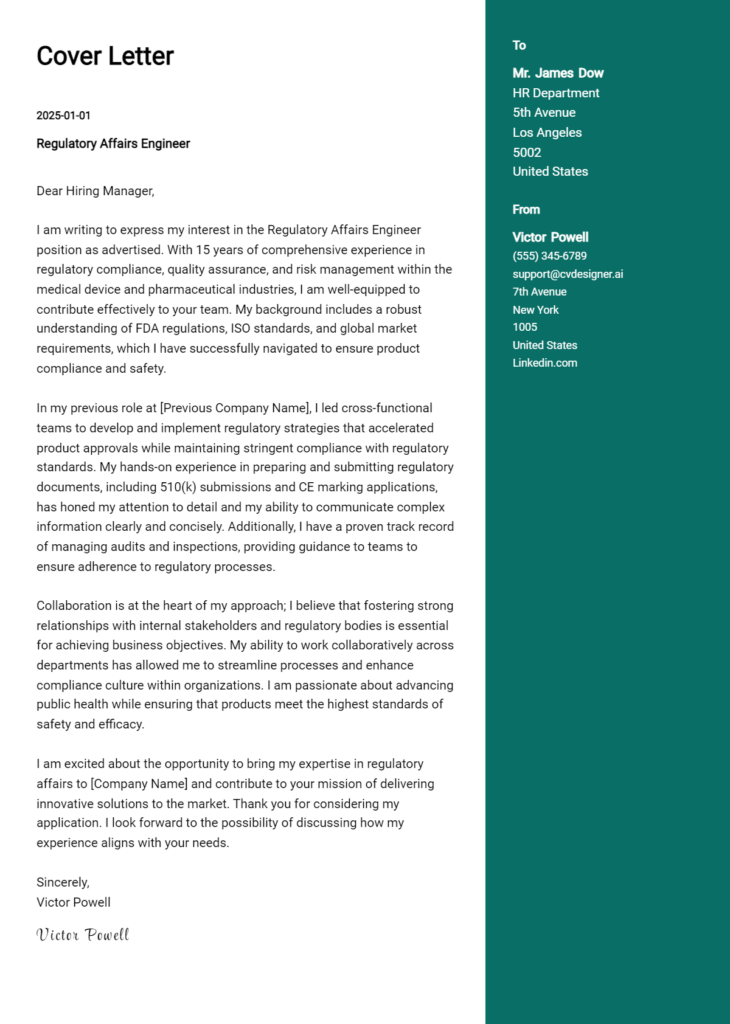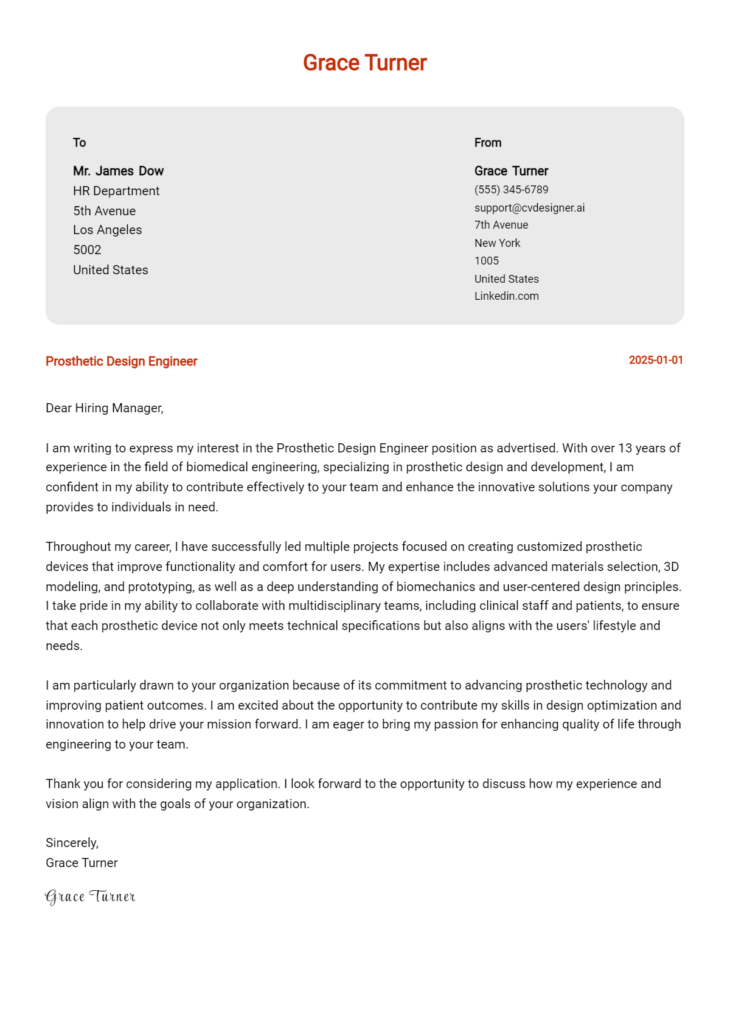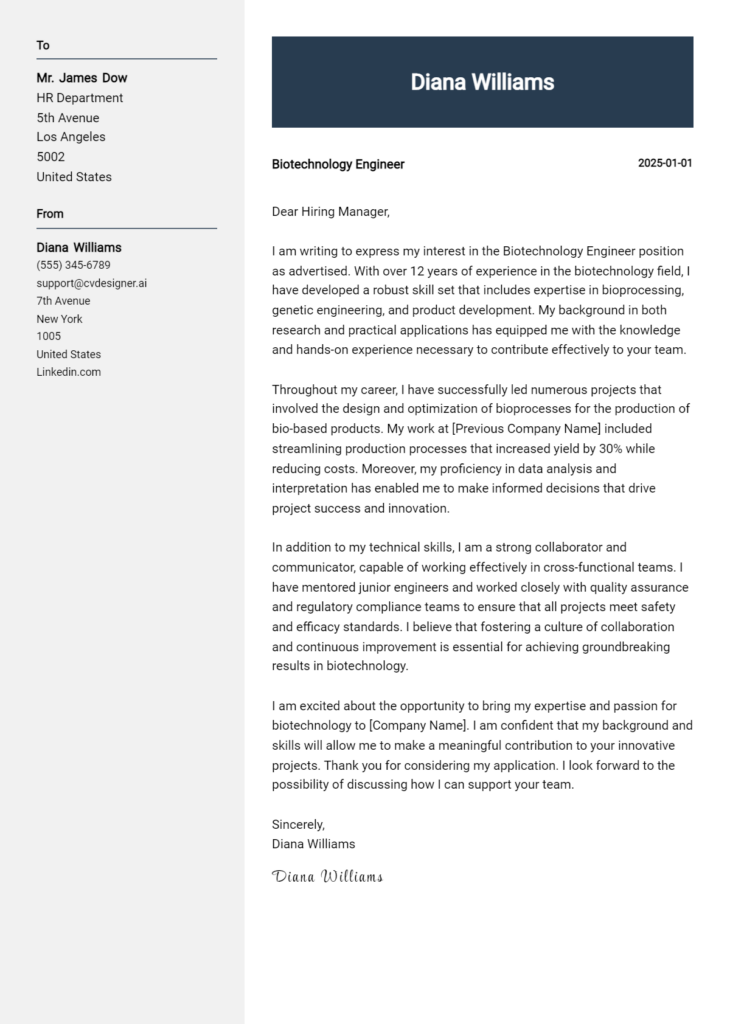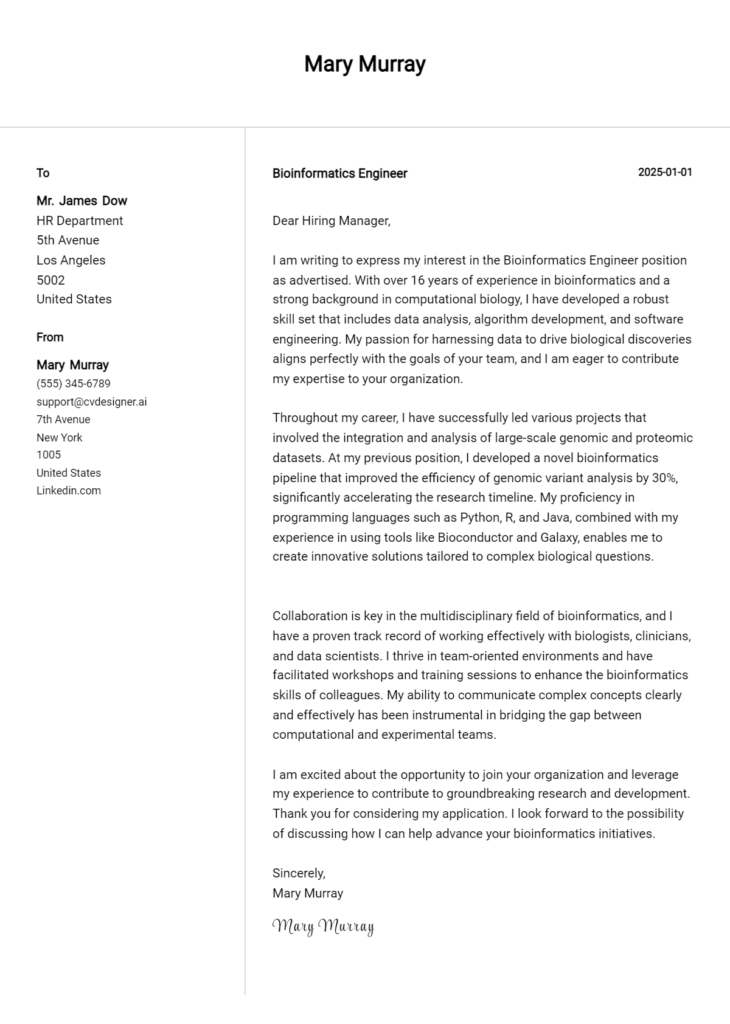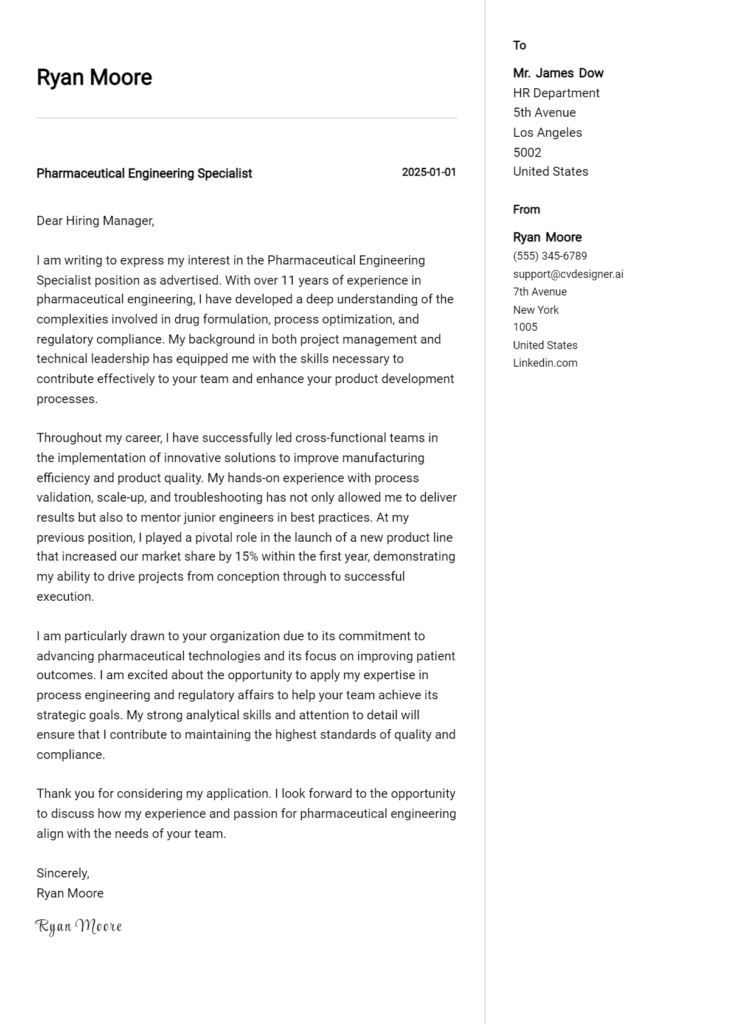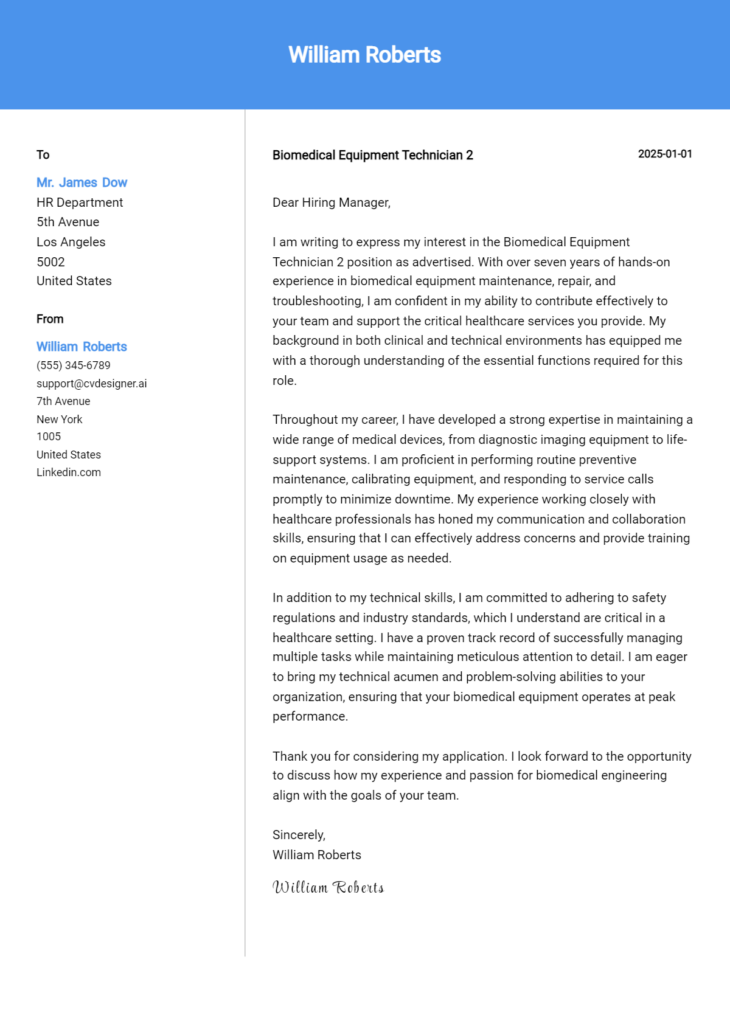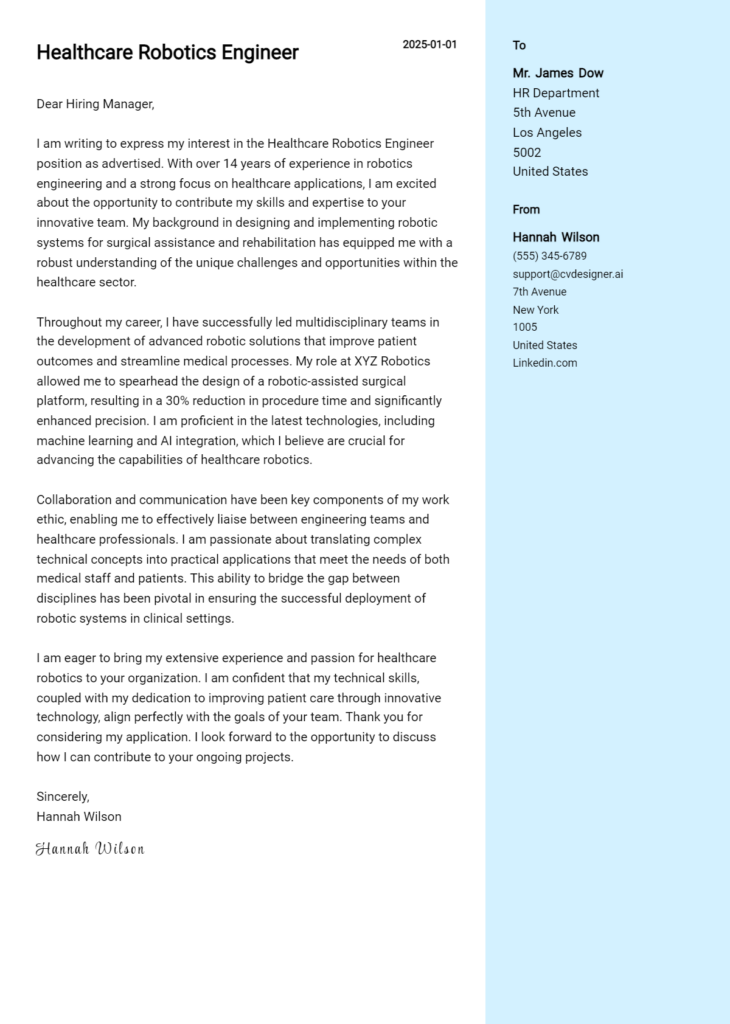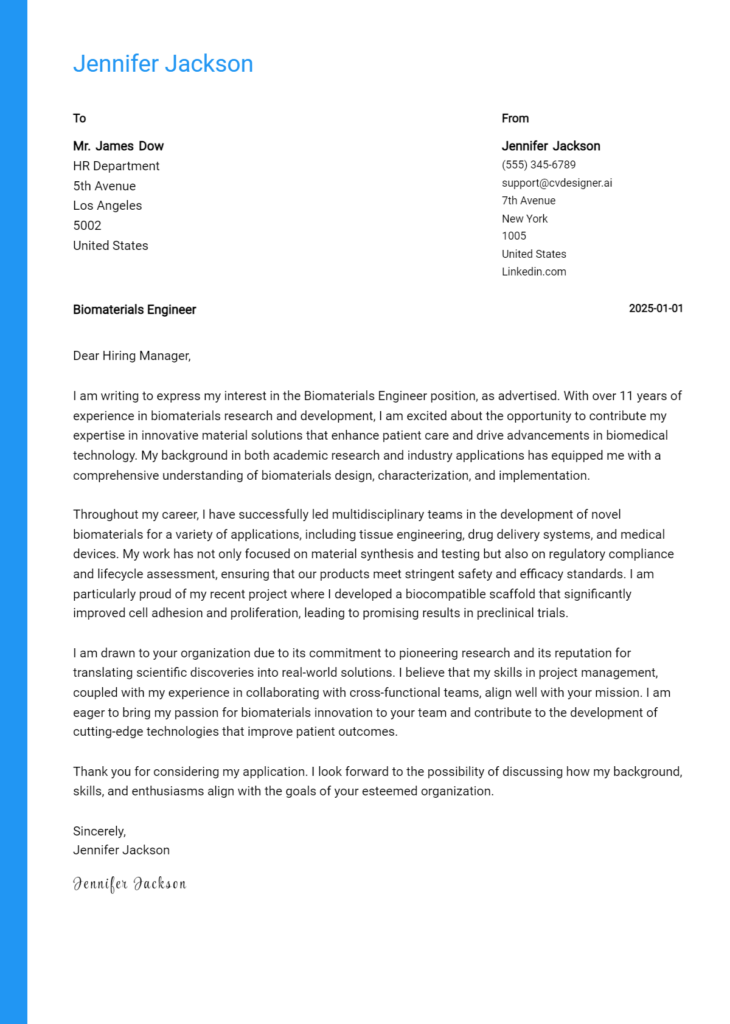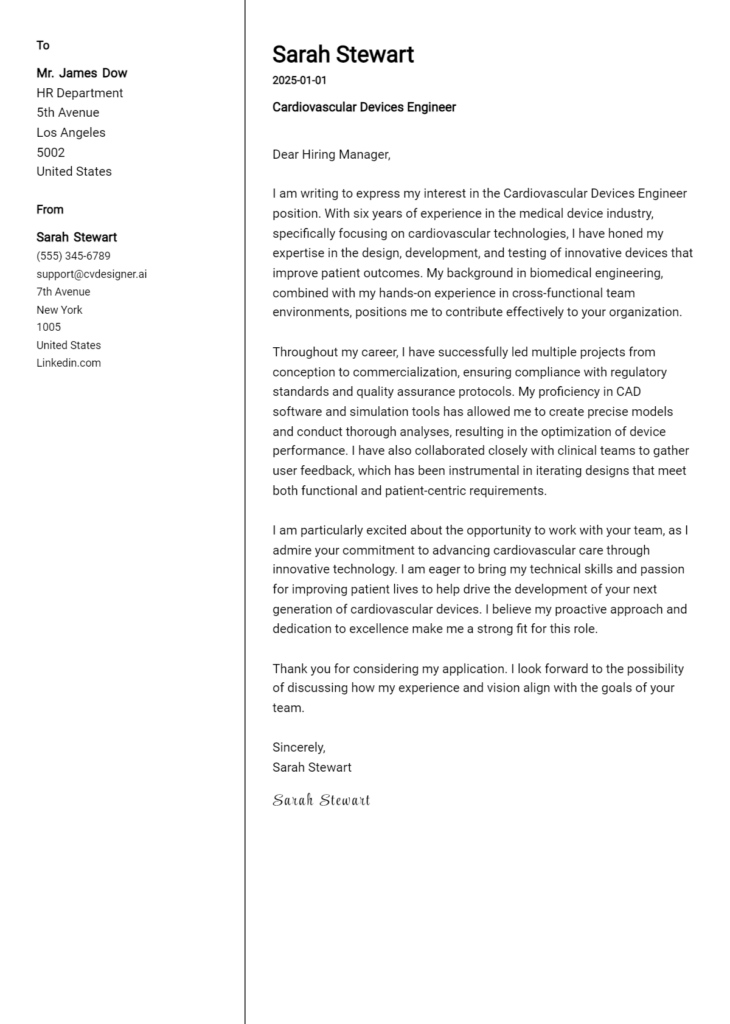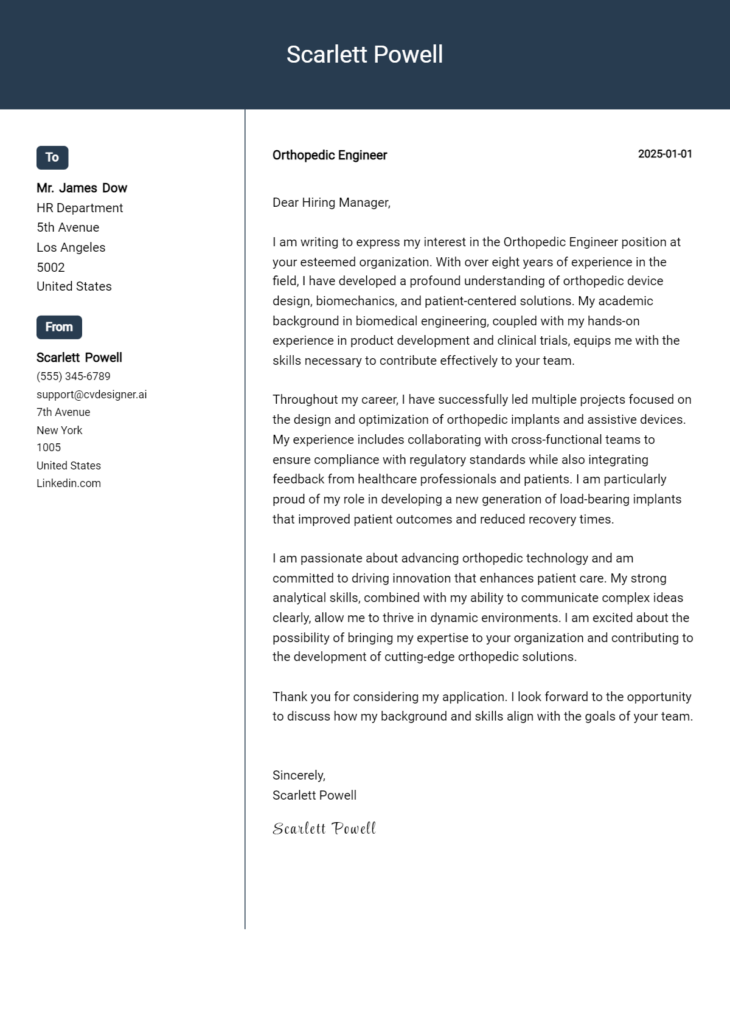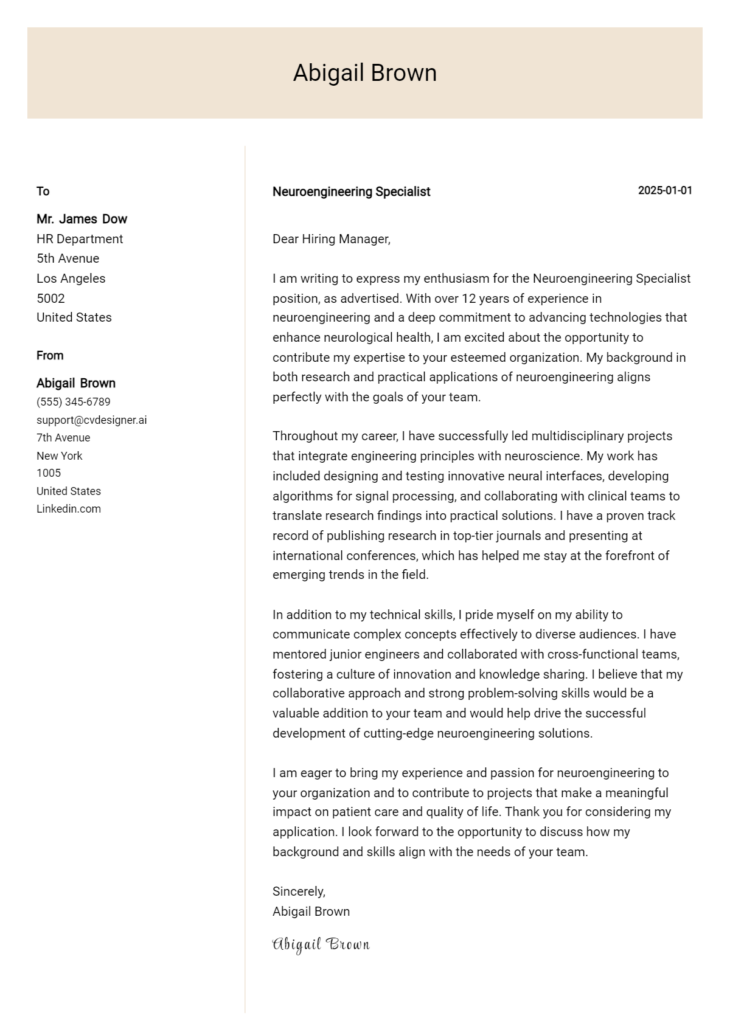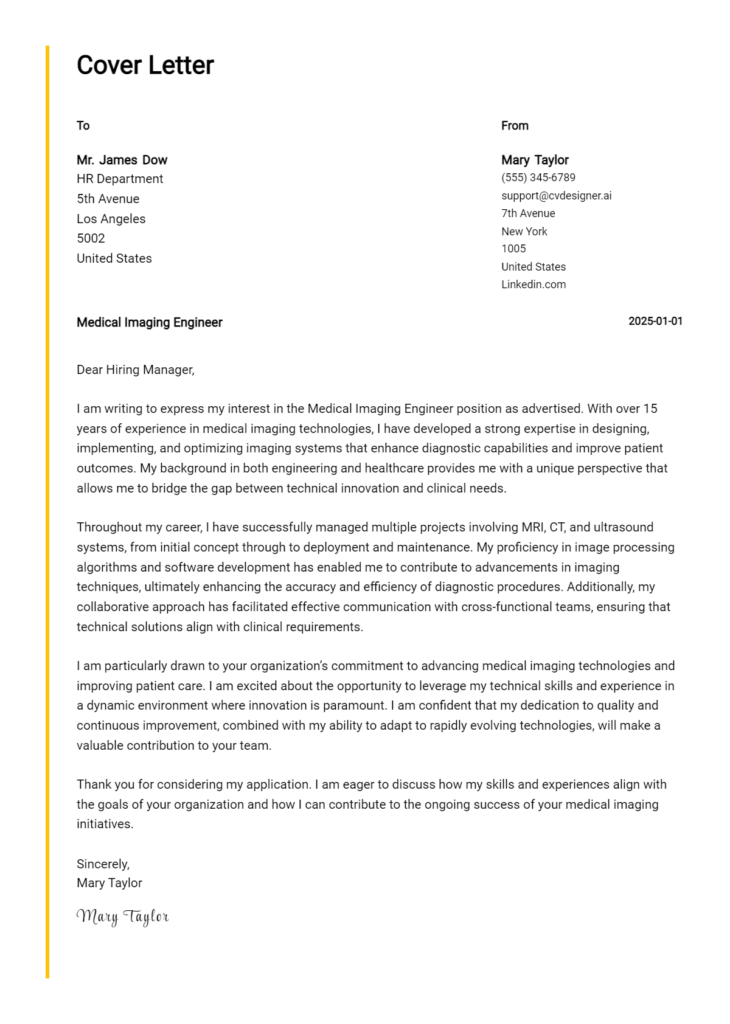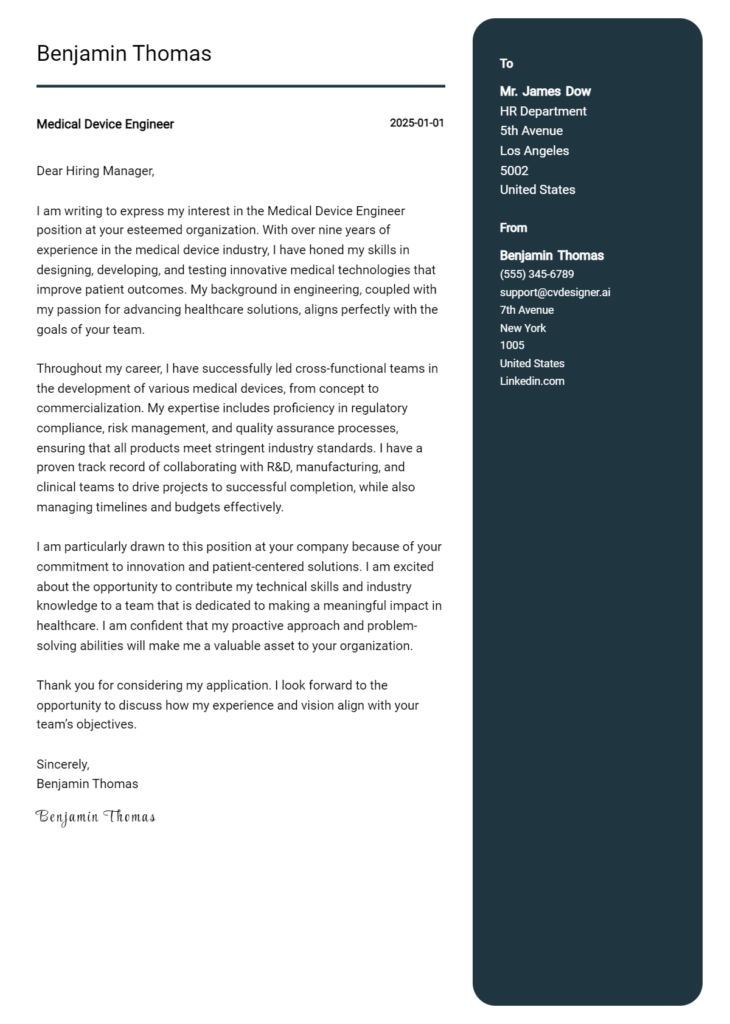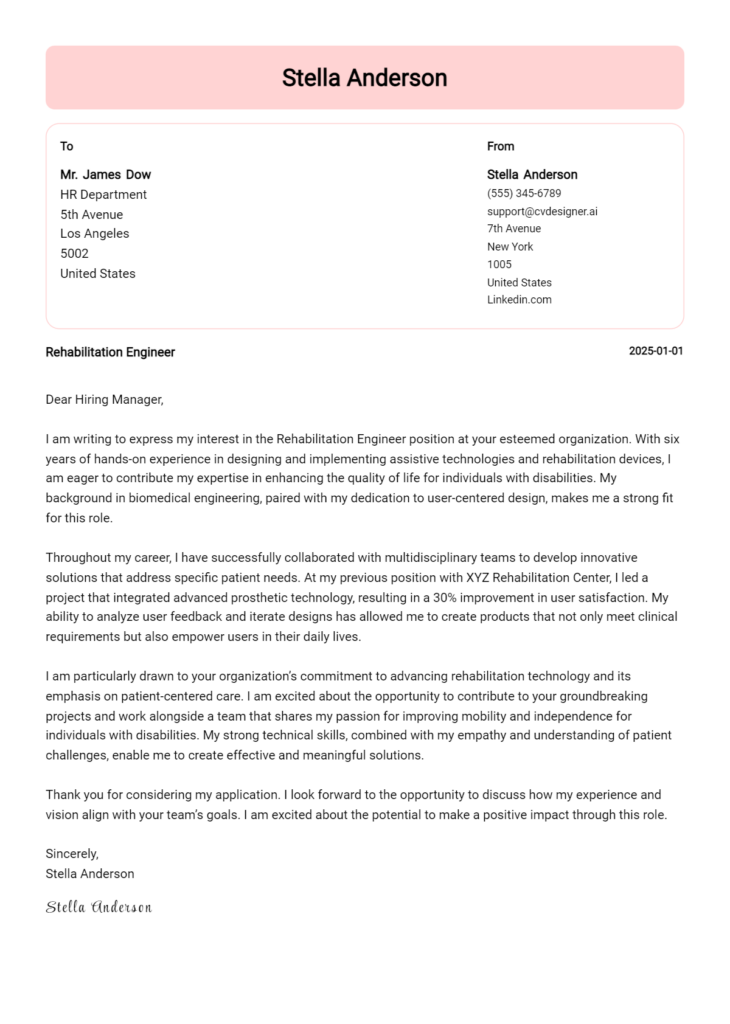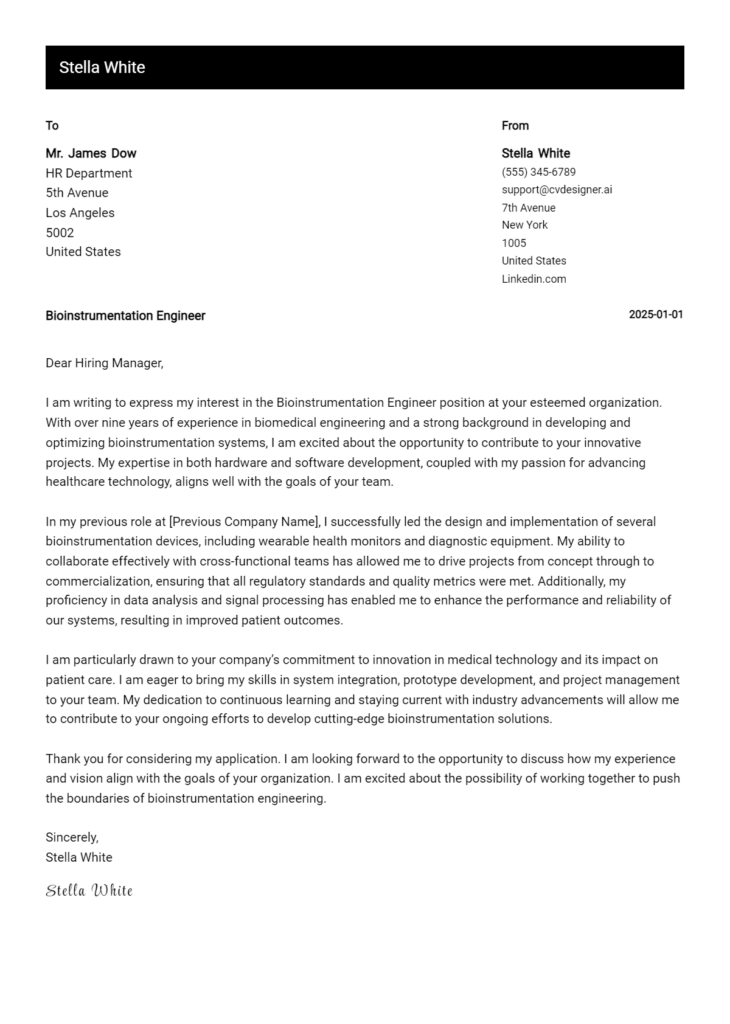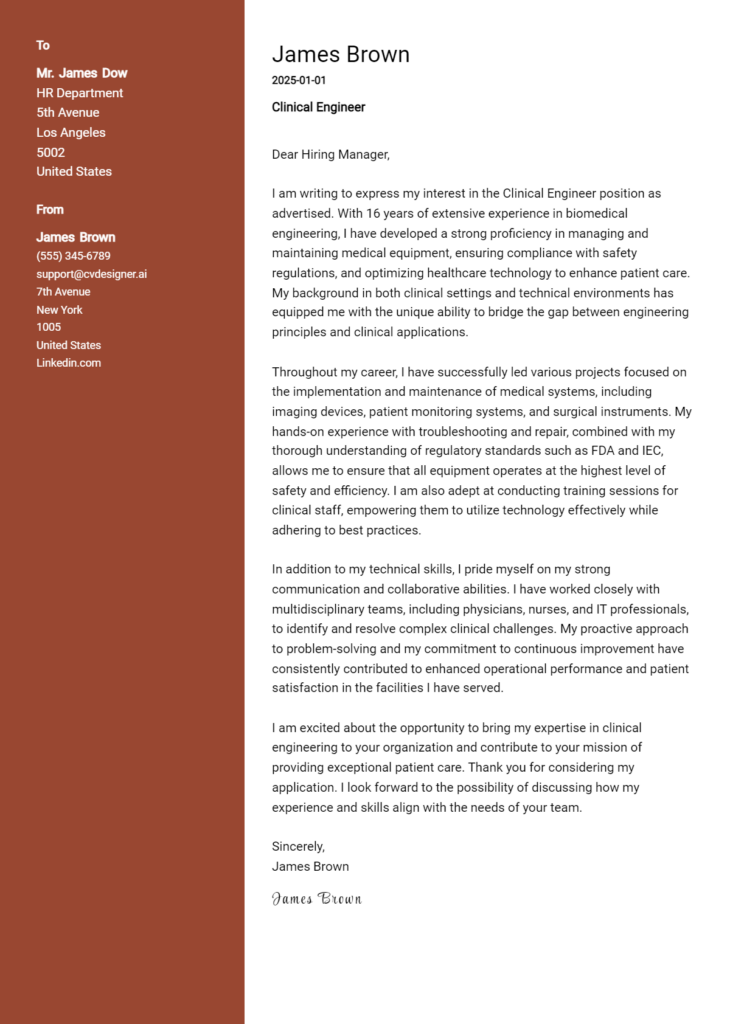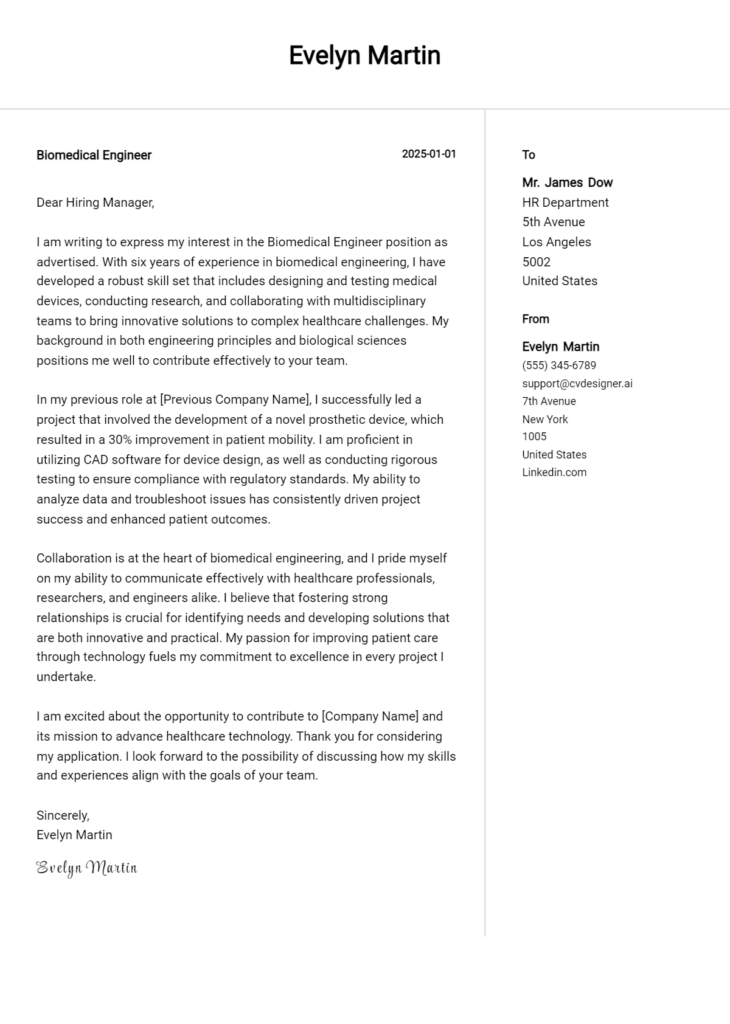Cardiovascular Devices Engineer 2 Cover Letter Examples
Explore additional Cardiovascular Devices Engineer 2 cover letter samples and guides and see what works for your level of experience or role.
How to Format a Cardiovascular Devices Engineer Cover Letter?
Crafting an impactful cover letter is essential for a Cardiovascular Devices Engineer, as it serves as your first impression with potential employers. The way you present your skills, experience, and passion for medical technology is crucial, reflecting your ability to innovate and ensure patient safety—key components in the field of cardiovascular devices. A well-structured cover letter not only captures the hiring manager's attention but also demonstrates your technical expertise and attention to detail.
In this guide, we will delve into the essential elements of a professional cover letter, providing insights and cardiovascular devices-specific examples to help you create a compelling document.
We will focus on the essential components of a professional cover letter, including:
- Cover Letter Header
- Cover Letter Greeting
- Cover Letter Introduction
- Cover Letter Body
- Cover Letter Closing
Each section plays a vital role in showcasing your qualifications and professionalism. Let’s break down each part and explain how to make your cardiovascular devices engineer cover letter stand out.
Importance of a Cover Letter Header for a Cardiovascular Devices Engineer
The cover letter header is a vital component that sets the tone for your application as a Cardiovascular Devices Engineer. It provides essential information that allows the recipient to identify you quickly and understand the context of your communication. A well-structured header should include your contact information, the date, and the recipient's details. Clarity and professionalism are paramount, as they reflect your attention to detail and commitment to the role. A strong header enhances your first impression, while a poorly formatted one can detract from your overall application.
Strong Example
John Doe 123 Heart Lane Cardio City, ST 12345 (123) 456-7890 johndoe@email.com October 1, 2023 Jane Smith Hiring Manager Cardiac Innovations Inc. 456 Pulse Avenue Heartsville, ST 67890
Weak Example
john doe 123 heart lane cardio city, st 12345 october 1, 2023 jane smith hiring manager cardiac innovations inc.
The Importance of the Cover Letter Greeting for a Cardiovascular Devices Engineer
The greeting of your cover letter is crucial as it sets the tone for the entire document and creates the first impression on the hiring manager. A well-crafted greeting not only demonstrates professionalism but also adds a personal touch by directly addressing the individual responsible for the hiring process. This approach reflects your attention to detail and genuine interest in the position. To make a strong impact, it’s important to avoid generic greetings such as "To Whom It May Concern," which can come off as impersonal. Instead, take the time to research the hiring manager’s name and title, showcasing your commitment to the application and the company.
Here are examples of strong and weak greetings for a Cardiovascular Devices Engineer cover letter:
Strong Greeting Example
Dear Dr. Jane Smith,
Weak Greeting Example
To Whom It May Concern,
The Importance of a Compelling Cover Letter Introduction for a Cardiovascular Devices Engineer
A well-crafted cover letter introduction is crucial for a Cardiovascular Devices Engineer, as it serves as the first impression to the hiring manager. This initial paragraph should not only capture attention but also convey genuine interest in the position and the company. It is an opportunity to succinctly highlight key skills, relevant experiences, or notable achievements that align with the job requirements. A strong introduction can set the tone for the rest of the cover letter, making it essential for candidates to find the right balance between professionalism and enthusiasm.
Strong Example
Dear [Hiring Manager's Name], I am excited to apply for the Cardiovascular Devices Engineer position at [Company Name], as I have dedicated the last five years of my career to advancing innovative medical technologies that improve patient outcomes. My experience in developing cutting-edge cardiac devices, coupled with my passion for enhancing cardiovascular health, aligns perfectly with your mission to revolutionize patient care. At [Previous Company], I successfully led a team that designed and launched a new stent that reduced complications by 30%, showcasing my ability to deliver results in high-pressure environments.
Weak Example
To whom it may concern, I am applying for the Cardiovascular Devices Engineer job. I have worked in engineering for a while, and I think I could be a good fit for your company. My experience includes working on some projects, but I don’t have specific examples to share. I hope you consider my application.
Purpose of the Cover Letter Body for a Cardiovascular Devices Engineer
The cover letter body for a Cardiovascular Devices Engineer serves as a critical platform for candidates to articulate their technical expertise, relevant experiences, and the unique value they bring to the organization. This section should effectively highlight specific projects or accomplishments that demonstrate the candidate’s proficiency in designing, testing, and improving cardiovascular devices. By showcasing achievements, such as successful product launches, innovative design solutions, or collaborative projects with cross-functional teams, the candidate can make a compelling case for their fit within the company. A well-crafted cover letter body not only reflects the applicant's capabilities but also conveys enthusiasm for the role and a commitment to advancing healthcare technology.
Strong Example
I am excited to apply for the Cardiovascular Devices Engineer position at [Company Name]. In my previous role at [Previous Company], I led a team in the development of a novel stent design that improved patient outcomes by 30%. This project required extensive collaboration with clinical teams and adherence to regulatory standards, resulting in a successful FDA submission. Additionally, I have experience with computational fluid dynamics modeling, which I utilized to optimize device performance. I am confident that my background in both engineering and clinical application will allow me to make significant contributions to [Company Name]'s innovative product line.
Weak Example
I would like to apply for the Cardiovascular Devices Engineer position. I have worked in engineering for a few years and have experience with some devices. In my last job, I did a project that involved working on a stent. I think I would be a good fit for your company because I like cardiovascular devices and want to help people.
Importance of the Cover Letter Closing for a Cardiovascular Devices Engineer
The closing of a cover letter is crucial as it provides an opportunity to summarize your qualifications, reiterate your enthusiasm for the role, and encourage the hiring manager to take the next steps, such as reviewing your resume or scheduling an interview. A strong closing can leave a lasting impression, highlighting your suitability for the position and your eagerness to contribute to the team. In contrast, a weak closing may fail to engage the reader, resulting in missed opportunities.
Strong Example
Thank you for considering my application for the Cardiovascular Devices Engineer position. With my extensive experience in developing innovative cardiac devices and my passion for improving patient outcomes, I am excited about the opportunity to contribute to your esteemed team at [Company Name]. I look forward to the possibility of discussing how my skills align with your needs and hope to schedule an interview at your earliest convenience. Please feel free to contact me to arrange a suitable time.
Weak Example
I appreciate you looking at my cover letter. I think I might be okay for this job. If you want, you can look at my resume. I guess I could talk to you more about it later.
Crafting an effective cover letter is crucial for candidates aiming for a position as a Cardiovascular Devices Engineer. This specialized role demands not only technical expertise but also strong problem-solving skills, a thorough understanding of the Software Development Life Cycle (SDLC), and the ability to work collaboratively within a team. Additionally, expressing a passion for continuous learning can set you apart in a competitive field. The following tips will guide you in highlighting these essential attributes in your cover letter, ensuring you make a lasting impression.
Tips for Writing a Cover Letter as a Cardiovascular Devices Engineer
Showcase Your Technical Skills
Highlight your proficiency with engineering principles specific to cardiovascular devices, such as materials science, electronics, and design software. Mention any relevant certifications or training you’ve received. Use specific examples to demonstrate how these skills have contributed to previous projects.Emphasize Problem-Solving Abilities
Provide concrete examples of challenges you’ve faced in previous roles and how you successfully addressed them. This could include troubleshooting device malfunctions, optimizing design processes, or enhancing product safety. Articulating your problem-solving strategies shows your capability to think critically in high-stakes environments.Demonstrate Knowledge of SDLC
Illustrate your understanding of the Software Development Life Cycle, particularly how it applies to the development of medical devices. Discuss your experience in various phases, from requirements gathering to testing and validation. This knowledge is crucial for ensuring compliance with industry regulations and standards.Highlight Teamwork and Collaboration
Cardiovascular device engineering often involves working with multidisciplinary teams, including clinicians, researchers, and regulatory experts. Share instances where your collaboration contributed to successful project outcomes. This showcases your ability to communicate effectively and work harmoniously within a diverse group.Express a Passion for Continuous Learning
The field of cardiovascular devices is ever-evolving, making it essential to stay updated on the latest advancements and technologies. Mention any ongoing education, workshops, or professional development activities you are involved in. This demonstrates your commitment to personal growth and staying at the forefront of the industry.
By incorporating these elements into your cover letter, you'll create a compelling narrative that positions you as a qualified candidate for the role of Cardiovascular Devices Engineer. For further assistance, consider utilizing cover letter templates or a cover letter builder to streamline your writing process.
Common Mistakes to Avoid in a Cardiovascular Devices Engineer Cover Letter
Avoiding common mistakes in a cover letter is crucial for standing out as a candidate for a Cardiovascular Devices Engineer position. A well-crafted cover letter can make a significant difference in your job application, while errors can undermine your professionalism and technical expertise. Here are some common pitfalls to watch for:
Generic Language: Using a one-size-fits-all template can make your cover letter feel impersonal. Tailor your letter to the specific job and company by including relevant experiences and skills.
Lack of Specificity: Failing to highlight specific accomplishments related to cardiovascular devices can weaken your application. Include measurable results and relevant projects to demonstrate your impact.
Ignoring Keywords: Not incorporating keywords from the job description can cause your application to be overlooked. Review the listing carefully and use pertinent terms to align your qualifications with the employer's needs.
Poor Formatting: A cluttered or unprofessional format can distract from your message. Use a clean, professional cover letter format that is easy to read and visually appealing.
Spelling and Grammar Errors: Typos can create a negative impression. Always proofread your letter multiple times, and consider asking a colleague to review it as well.
Overly Lengthy Letters: Being too verbose can dilute your key messages. Aim for a concise letter that clearly communicates your qualifications, ideally one page in length.
Neglecting a Strong Closing: A weak conclusion can leave a lasting impression of uncertainty. End with a strong closing statement that expresses enthusiasm for the position and invites further discussion.
By avoiding these mistakes and following best practices, you can create a compelling cover letter that effectively showcases your qualifications for a role in cardiovascular device engineering. For inspiration, check out some cover letter examples to help you get started.
Cover Letter FAQs for Cardiovascular Devices Engineer
What should I include in my cover letter for a Cardiovascular Devices Engineer position?
In your cover letter, it's essential to highlight your relevant qualifications and experiences. Start with a strong introduction that specifies the position you're applying for. Mention your educational background in biomedical engineering or a related field, along with any specialized training in cardiovascular devices. Detail your experience with design, development, and testing of medical devices, emphasizing any specific projects or technologies you’ve worked on. Include soft skills such as teamwork, communication, and problem-solving abilities, as these are crucial in a collaborative environment. Lastly, conclude with a statement about your passion for improving patient outcomes through innovative technology in cardiovascular health.
How can I demonstrate my technical skills in the cover letter?
To effectively demonstrate your technical skills as a Cardiovascular Devices Engineer, use specific examples from your past work experiences. Instead of merely listing skills, describe projects where you applied them. For instance, if you have experience with CAD software, mention a project where you designed a cardiovascular implant using that software. Discuss any hands-on experience you have with prototyping, testing, or regulatory compliance for medical devices. Additionally, highlight any certifications or specialized training that enhance your technical competency. This approach provides concrete evidence of your skills and shows how they can benefit the potential employer.
Should I tailor my cover letter for each job application?
Yes, tailoring your cover letter for each job application is crucial, especially in specialized fields like cardiovascular device engineering. Each company may focus on different aspects of device development, regulatory compliance, or market needs. Research the company and its product line to understand their specific challenges and goals. Then, customize your cover letter to align your skills and experiences with the company's needs. Mention any relevant projects or experiences that directly relate to their work. This personalized approach not only shows your genuine interest in the role but also demonstrates that you have taken the time to understand the organization.
How long should my cover letter be?
Your cover letter for a Cardiovascular Devices Engineer position should typically be one page long, consisting of three to four paragraphs. Aim for a length of about 250 to 400 words. This length is sufficient to convey your qualifications, experiences, and enthusiasm without overwhelming the hiring manager. Focus on clarity and conciseness; each sentence should add value to your application. Use paragraph breaks effectively to enhance readability, and ensure that your most compelling points are presented early on. Remember, the goal is to entice the employer to review your resume and invite you for an interview, so make every word count!
Build your Cover Letter in minutes
Use an AI-powered cover letter builder and have your letter done in 5 minutes. Just select your template and our software will guide you through the process.

